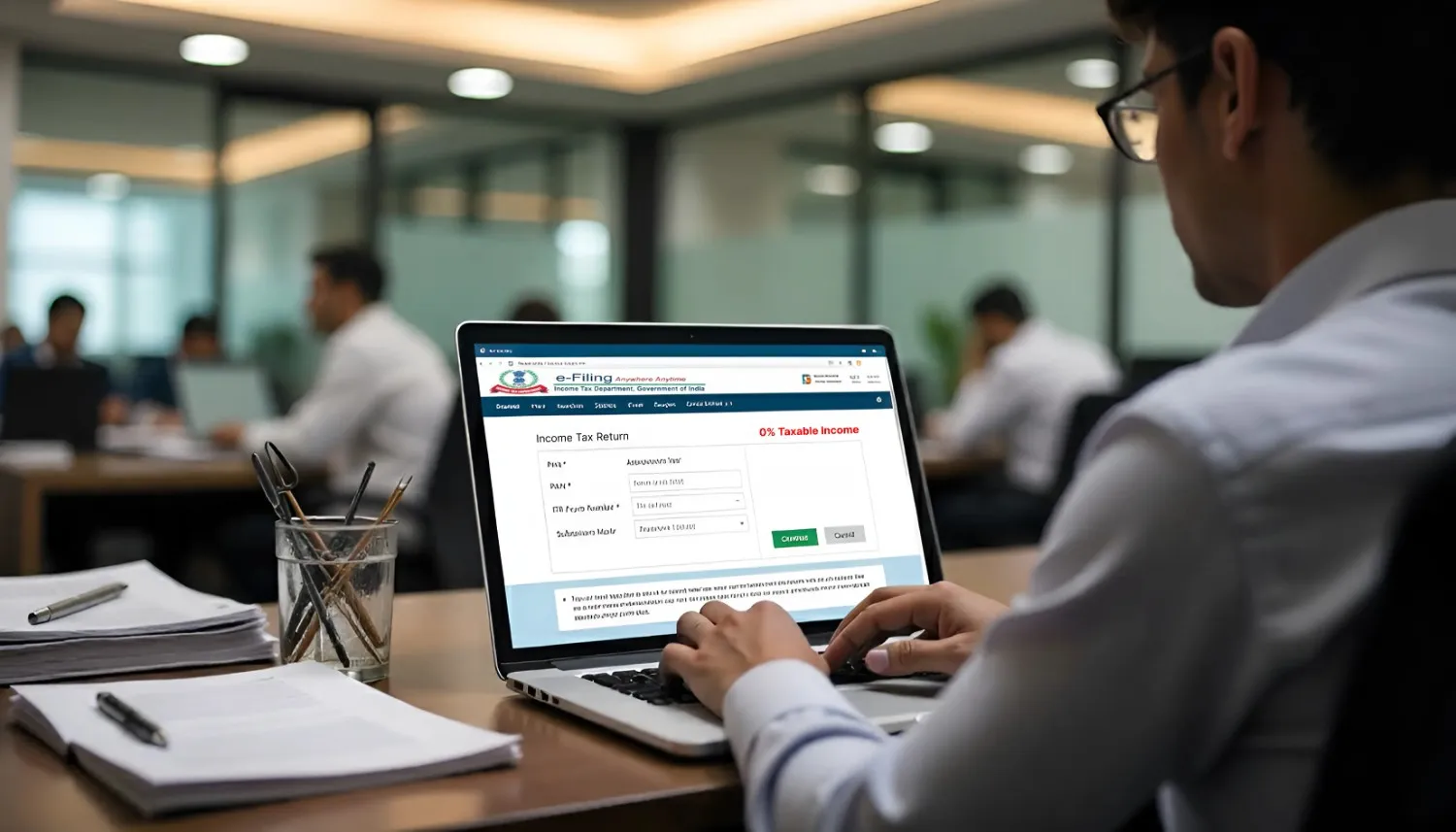
Introduction
HRA in income tax return is a crucial component of tax planning for salaried employees, allowing them to claim exemptions on rent paid and reduce their taxable income. The House Rent Allowance (HRA) is an integral part of a salary structure, designed to provide financial relief to those living in rented accommodations. However, many employees either miss out on claiming an HRA exemption claim or miscalculate the amount, leading to lost tax benefits or compliance issues. Understanding how to claim HRA in income tax return correctly is essential for maximizing savings while ensuring adherence to tax laws.
To avail of the house rent allowance deduction, employees must meet specific eligibility criteria and provide the necessary documents as proof required for HRA. The exemption is calculated based on a formula that considers actual rent paid, salary components, and city of residence (metro or non-metro). Many taxpayers struggle with these calculations, but using an income tax calculator with HRA can simplify the process and help determine the exact exemption amount.
One of the most common mistakes in claiming HRA in income tax return is the lack of proper documentation. To ensure a hassle-free HRA exemption claim, employees must maintain valid rent receipts, lease agreements, and, in some cases, the landlord’s PAN details (if annual rent exceeds ₹1,00,000). Understanding the proof required for HRA and keeping these documents ready can help avoid unnecessary scrutiny from tax authorities.
Additionally, it’s vital for HRA for salaried employees to be accurately declared in their ITR filing. The exemption under HRA in income tax return is governed by Section 10(13A) of the Income Tax Act, and employees must correctly enter the details while filing their returns.
This guide will walk you through everything you need to know about HRA in income tax return—eligibility, how to calculate house rent allowance deduction, documents needed, common mistakes to avoid, and how to use an income tax calculator with HRA for accurate filing. By the end, you will be well-equipped to claim an HRA exemption claim efficiently while ensuring compliance with tax regulations.
Also Read: Complete Guide To Tds On Salary Section 192 Explained
What is House Rent Allowance (HRA)?
Housing Rent Allowance (HRA) is a salary component that employers provide to employees who live in rented accommodations. This allowance helps reduce tax liability under Section 10(13A) of the Income Tax Act, 1961.
HRA is only partially taxable. A portion of the HRA received can be claimed as an exemption, while the remaining amount is added to taxable income. The exemption is calculated based on specific criteria, which we’ll discuss later.
What Is The Eligibility Criteria for HRA Exemption Under Section 10(13A)?
Not all salaried individuals qualify for an HRA exemption claim. You must meet the following conditions:
- You must be a salaried employee. Only salaried employees receiving HRA as part of their salary can claim the exemption.
- You must live in rented accommodation. If you own the house you live in, you cannot claim HRA.
- Rent must be paid to a landlord. Payments to parents or relatives are acceptable, but you must have proper proof.
- If the rent exceeds ₹1,00,000 per year, the PAN of the landlord is required.
- Self-employed individuals cannot claim HRA exemption under Section 10(13A) but can use Section 80GG for tax benefits.
If you qualify, you must ensure proper documentation to support your house rent allowance deduction claim.
Step-by-Step Guide to Claim HRA in Income Tax Return
Here’s how to add HRA in income tax return efficiently:
Step 1: Check Your Salary Slip
- Verify if HRA is part of your salary. It is usually mentioned separately on the payslip.
Step 2: Collect Rent Receipts
- If your monthly rent exceeds ₹3,000, you need to submit rent receipts to your employer.
- For rent exceeding ₹1,00,000 per year, you must provide the landlord’s PAN.
Step 3: Use the HRA Exemption Formula
To calculate the house rent allowance deduction, use the formula below. The exempted HRA amount is the lowest of the following three:
- Actual HRA received from employer
- 50% of basic salary (for metro cities) or 40% of basic salary (for non-metro cities)
- Rent paid minus 10% of basic salary
Step 4: Declare HRA While Filing ITR
- If your employer has considered HRA in Form 16, it will automatically reflect in ITR-1 under “Salary Breakdown.”
- If not, manually enter the HRA exemption amount in the “Income from Salary” section under “Allowances to the extent exempt under section 10.”
Step 5: Use an Income Tax Calculator with HRA
For accuracy, use an income tax calculator with HRA to check your exemption.
What Are The Documents Required for HRA Exemption?
To claim an HRA exemption claim, keep the following documents:
- Rent receipts with details like landlord name, address, rent amount, and tenant details.
- Rental agreement (if applicable).
- Landlord’s PAN card copy (mandatory if rent exceeds ₹1,00,000 annually).
- Proof of rent payment, such as bank statements or digital payment records.
Maintaining proper proof required for HRA ensures a hassle-free exemption process.
How to Calculate HRA Exemption Amount?
Let’s understand the house rent allowance deduction with an example.
Example Calculation
Details:
- Basic Salary: ₹50,000 per month
- HRA Received: ₹20,000 per month
- Rent Paid: ₹15,000 per month
- Metro City Resident (50% rule applies)
HRA Exemption Calculation:
- Actual HRA received: ₹20,000 × 12 = ₹2,40,000
- 50% of Basic Salary: ₹50,000 × 50% × 12 = ₹3,00,000
- Rent Paid – 10% of Basic Salary: (₹15,000 × 12) – (10% of ₹50,000 × 12) = ₹1,80,000 – ₹60,000 = ₹1,20,000
The lowest of these three values is ₹1,20,000, so this amount is exempt from tax.
For quick calculations, use an income tax calculator with HRA online.
What Are The Common Mistakes to Avoid While Claiming HRA?
Many employees make errors while filing how to add HRA in their income tax return. Here are some common pitfalls:
1. Not Submitting Rent Receipts
- Many assume salary slips are enough, but employers need rent receipts as proof.
2. Claiming HRA While Living in Own House
- HRA is only for rented accommodations. If you live in your own house, you cannot claim HRA.
3. Incorrect Calculation
- Miscalculating HRA can result in excess tax liability or legal trouble. Always use an income tax calculator with HRA.
4. Missing Landlord’s PAN Details
- If your annual rent exceeds ₹1,00,000, you must submit the landlord’s PAN to claim HRA.
Conclusion
Claiming HRA in income tax return is one of the most effective ways for salaried individuals to reduce their taxable income while ensuring compliance with tax regulations. Understanding the HRA exemption claim process, along with the necessary documentation, is essential to maximizing your tax benefits. Proper planning and the right approach to claiming house rent allowance deductions can help you optimize your tax savings and avoid common pitfalls such as miscalculating exemption amounts or failing to provide the proof required for HRA. Many taxpayers make errors by not keeping rent receipts, claiming excess deductions, or misunderstanding the income tax calculator with HRA, which can lead to complications in tax filings.
For HRA for salaried employees, ensuring accurate calculations and proper record-keeping is crucial for a hassle-free tax return filing. By using an income tax calculator with HRA, taxpayers can accurately determine their eligible exemption and make the most of the available deductions. If you’re unsure about how to claim HRA in your income tax return, seeking professional assistance can help prevent errors and ensure compliance with tax laws.
Ready to get started? Reach out to trusted platforms like RegisterKaro and make your compliance journey hassle-free, allowing you to focus on what truly matters—growing your business. Contact our support team at [email protected] today.




